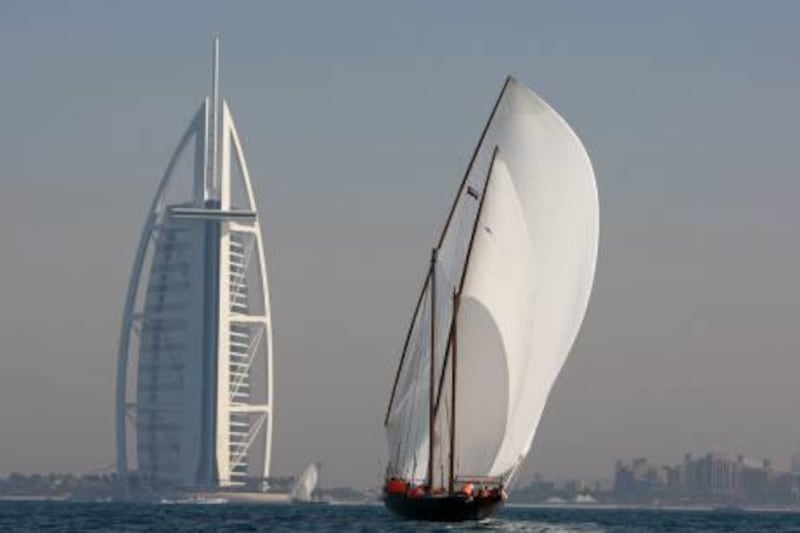DUBAI // It is one of the city's best known and most instantly recognisable symbols, a unique and daring structure that helped to put the UAE on the world map.
But according to its architect, the Burj Al Arab hotel would probably not be built that way if it were being designed today.
Special report: Modern icons
The UAE has been described as an architect’s playground.As buildings continue to spring up in Abu Dhabi and Dubai, we take a look at some of the unique designs and the stories that they tell.
[ More from The National on modern icons ]
"In 1993, a huge sail-shaped building seemed like a great idea," Tom Wright said. "In today's austere world, perhaps we would discard the idea as being too extravagant.
"It is a building of its time; it says a lot about the aspirations of the people of Dubai in the late 20th-century."
The brief given to Mr Wright was to design a building that would be to Dubai what the Eiffel Tower was to Paris and the Opera House was to Sydney.
"It was quite a challenge," he said. "We had a couple of weeks to come up with a building that would put Dubai on the map.
"We looked at other iconic buildings around the world and came to the obvious conclusion that they were all unique in form, so we knew that our solution would also have to be unlike anything that had ever been done before."
Other designs were considered but the sail shape was always the clear favourite.
"We had a bunch of solutions at the first presentation but only one that we really liked, that we thought had a chance of becoming iconic," Mr Wright said.
"The idea of a sail had already been used in Dubai at the Creek Golf Club, which is an interpretation of a dhow sail, and I guess this building planted the seed of the idea. It was also designed for the same client so we knew the sail concept was liked."
Some accounts say the building's shape is based, like that of the golf club, on a traditional dhow sail, while others say the inspiration came from a sleek modern racing yacht. Mr Wright put to rest the discussion.
"The shape is definitely based on a modern sail," he said. "The modern sail form said something about the future aspirations of Dubai as a major tourism destination."
The British-born Mr Wright said he developed the shape by sketching the outline on a serviette with a felt pen while sitting in the Chicago Beach Hotel, now the site of the Jumeirah Beach Hotel.
By 1999, that rough drawing had become the imposing and unmistakable tower that now rises over Al Sufouh.
"If you can draw a building with a few sweeps of the pen and everyone recognises not only the structure but also associates it with a place on Earth, you have gone a long way towards creating something iconic," Mr Wright said soon after the building was completed.
The Burj, with its two-storey suites, personal butlers and interiors of marble and gold leaf, has become a byword for luxury and attracted many of the world's most celebrated leaders and stars. But it is also a remarkable engineering achievement.
Some of the building's secrets were revealed in a television programme that was screened recently in the UK. Richard Hammond's Engineering Connections demonstrated how the holes in the concrete sea defences and the spaces between them protect the artificial island on which the building stands.
The holes and gaps absorb the power of the waves by redirecting the water and breaking it up into harmless eddies and swirls.
When the sea defences were completed the builders found they had some of the concrete blocks left over, so they dropped them into the Gulf to form an artificial reef that has provided a habitat for fish and become a popular dive site.
The Burj stands not on rock, but on sand. The 321-metre tower is supported by 250 reinforced concrete pile foundations that were driven 40 metres into the seabed.
Mr Hammond showed how the tower is held up by a phenomenon known as skin friction, the resistance to movement generated whenever two surfaces - or skins - are brought together.
In the case of the Burj, the piles are held securely in place by the resistance between them and the sand in which they are buried.
Mr Wright is a director of Atkins, the UK engineering and design company that worked on the Burj project, which included construction of the Jumeirah Beach Hotel and the Wild Wadi waterpark. The hotel was built by the South African contractor Murray & Roberts.
Asked how he viewed the Burj today, 12 years after its opening, Mr Wright said: "Part of the responsibility of being an architect is to create buildings that make people feel good when they see them, especially if they have to see them every day.
"I am told that for many people the Burj achieves this goal, and this makes me feel good about imposing the design on the people of Dubai in the first place."
Height to the top of the mast: 321 metres
Height of the atrium: 180.5m
Height of the helipad: 212m
Maximum sway at the top of the highest suite: 30cm
Number of floors: 56
Number of suites: 202
Maximum height of the water jet in the atrium: 50m






